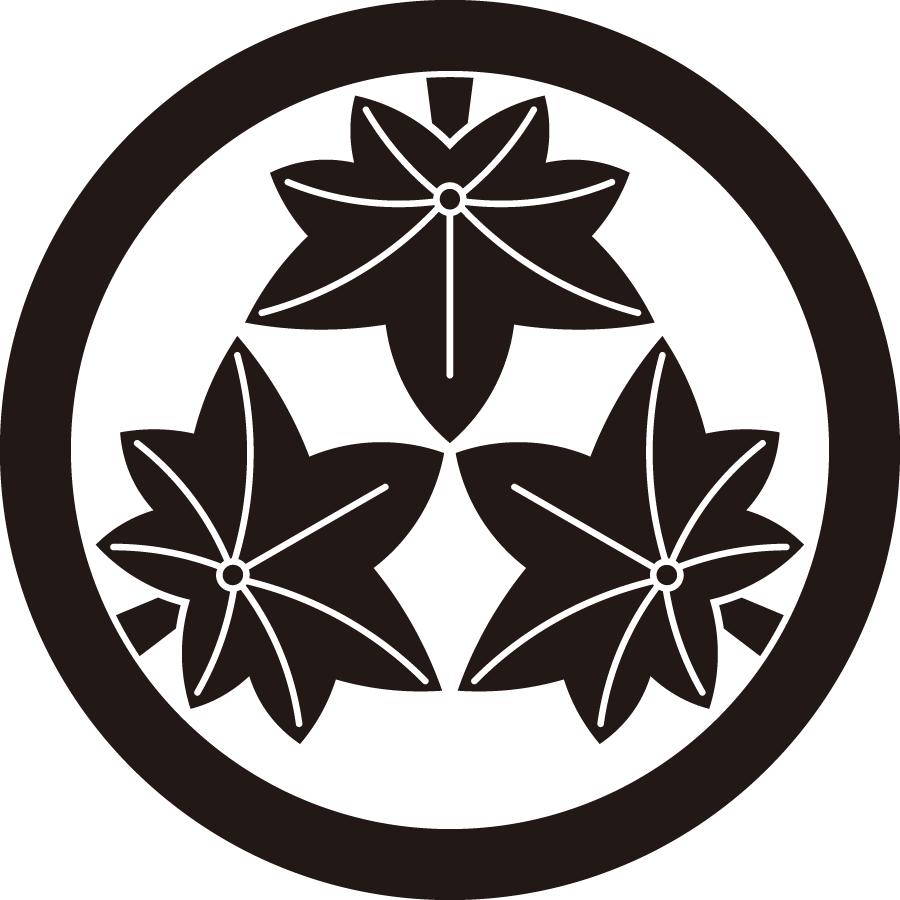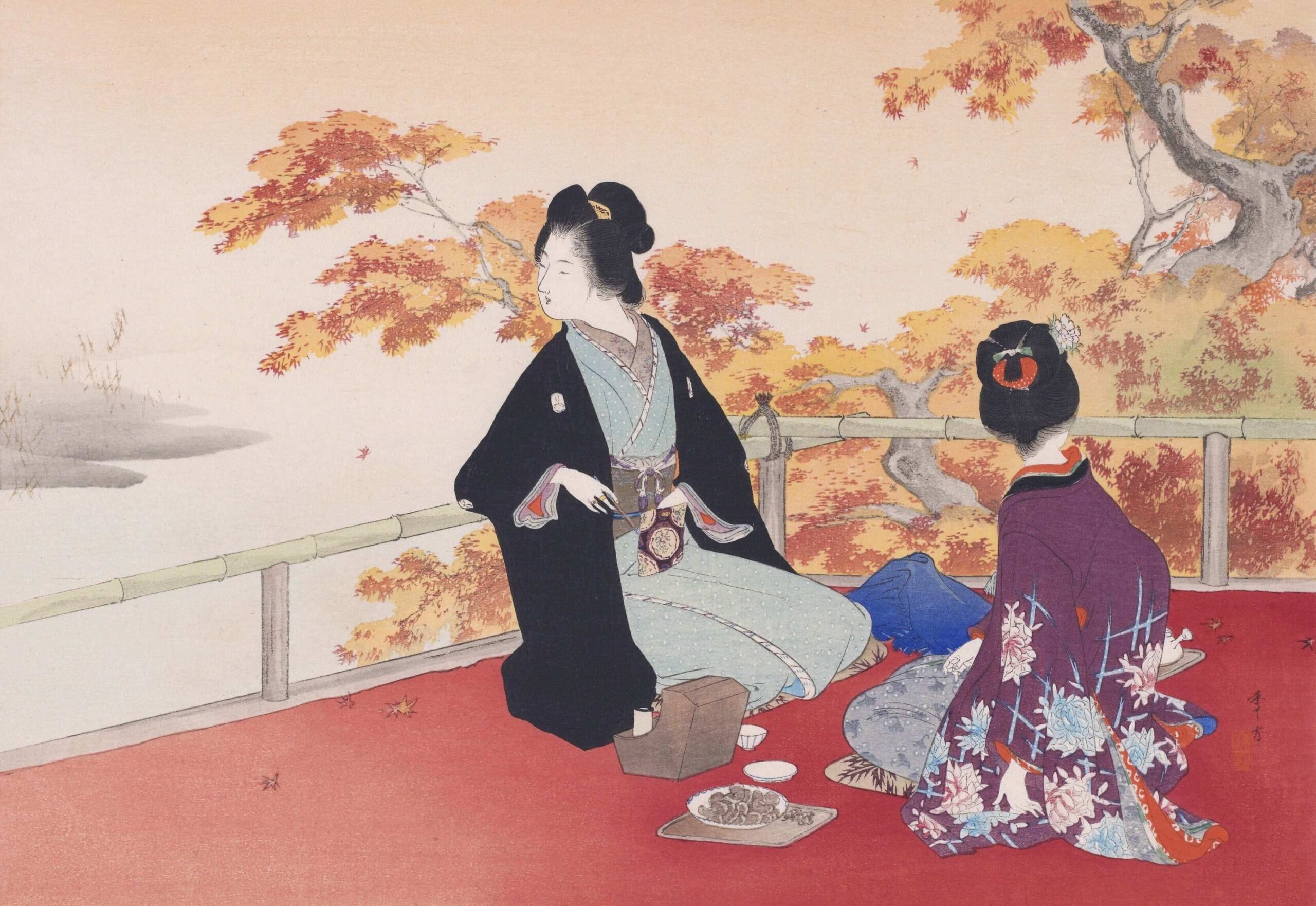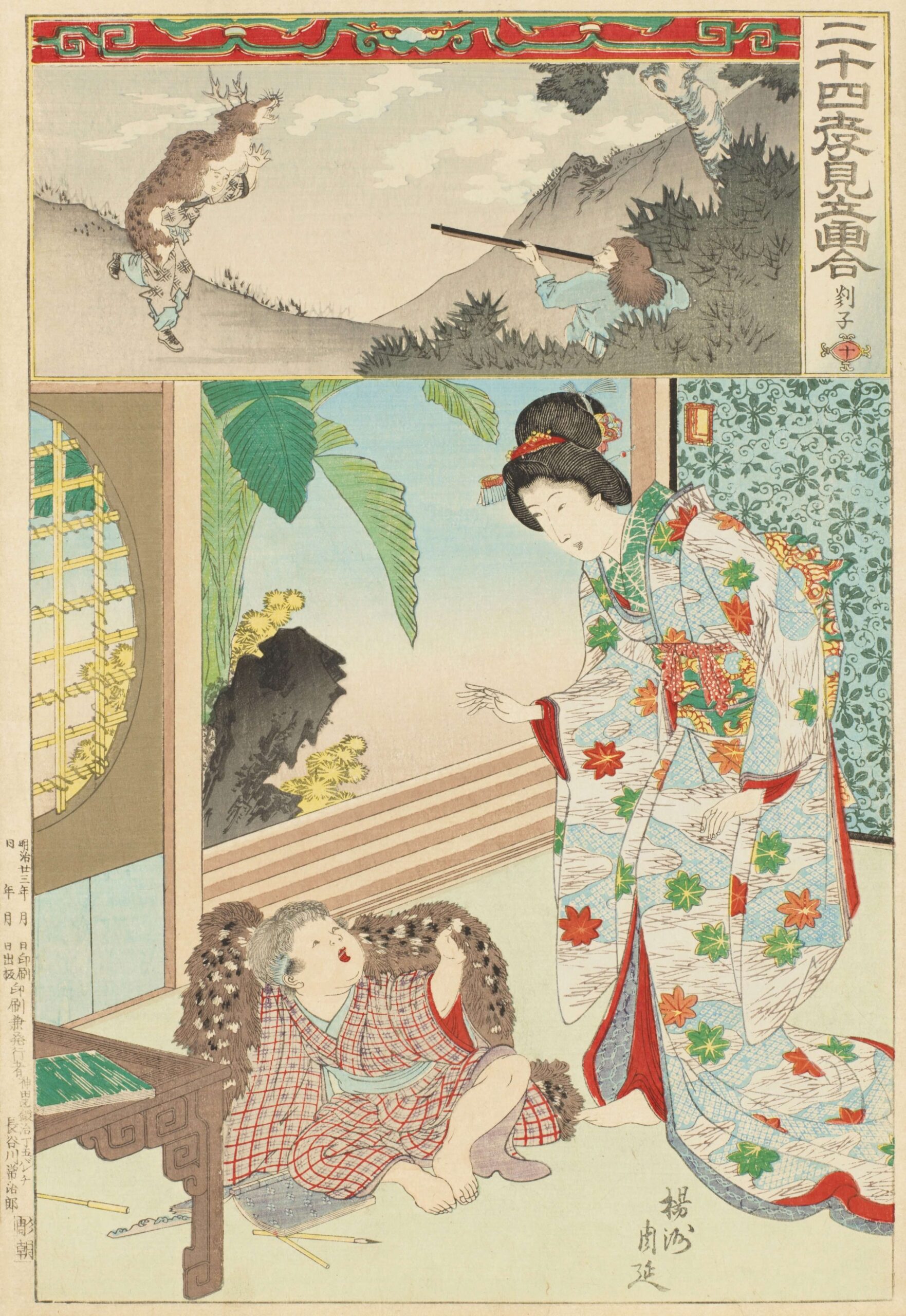It is truly beautiful to see the beautiful mountains dyed in red, and to feel the “autumn” of Japan.
From ancient times, Japanese people seem to have been familiar with maple leaves, as seen in the “Momiji no Ga (紅葉の賀)” (Autumn Leaves Celebration) held during the Heian period(794-1185). For these reasons, it is said that it was commonly used as a clothing pattern among the nobility, and eventually converted into a family crest (家紋).
Maple (楓/momiji) does not refer to a specific plant, but the family crest uses “maple leaves.” There are many variations, including single leaves, combined leaves and branches, and butterfly-shaped ones.
Users included the Imadegawa family (今出川家) of court nobles, the Ichikawa clan (市川氏) of the Ogasawara clan line (小笠原氏流), the Takayama clan (高山氏) of the Yoshifumi clan of the Taira clan line (平氏良文流), the Yagi clan(八木氏) of the Kusakabe clan line (日下部氏流), and Yukichi Fukuzawa (福沢諭吉), who was synonymous with the 10,000 yen note in modern times.
Let me introduce you to Maple pattern (楓文/kaede-mon)!
About Maple (楓/Kaede)?

Many Japanese refer to plants with palm-like red leaves as “momiji (紅葉)” in the image above.
One of the reasons the term “maple leaves(紅葉=もみじ)” has taken hold is that there are many idioms such as “Momijigari (紅葉狩り),” “Momiji Zensen (紅葉前線),” “Momiji ni Shika (紅葉に鹿),” and “Momiji Gasa (紅葉傘),” in which the word “maple leaves (紅葉)” is written and read as “maple leavesmaple (紅葉/momiji).”
*In Japan, “紅葉(maple)” is written and read as “Momiji” or “Koyo.” It’s confusing, isn’t it?
However, “Koyo (紅葉)” and “Momiji (紅葉)” technically have different meanings.
“Koyo (紅葉)” is basically a term used to describe a natural phenomenon or scenery in which the color of leaves changes to red or yellow when the temperature difference between the two areas increases. Autumn leaves were so called because in autumn the leaves turn red and the mountains in late autumn are beautifully colored. That’s why the term is used for various plants that change color in the fall. By the way, it is said that the Han name is Chi Kabuki.
“Momiji (紅葉)” is also used as another name for “maple (紅葉/momiji)” leaves, and is basically a term used to describe the plant itself. At the same time, it seems to be a word used for the color of leaves changing to red or yellow in autumn. This implies the same meaning as “Koyo (紅葉),” doesn’t it?
In other words, “The maple leaves (楓/kaede) turn maple leaves (紅葉/momiji) as they turn red (紅葉する/koyo-suru).”
I’m sorry for the confusing explanation. Just in case, here are the points.
| 【 紅葉(momiji) 】 | 【 紅葉(koyo) 】 |
|---|---|
| autumn / fall leaves autumn / fall foliage autumn / fall colors |
The leaves turn yellow. The leaves turn red. |
Now, is there a difference between maple (楓/kaede) and maple (紅葉/momiji)? It’s a problem.
*In Japan, the English word “maple” is distinctly referred to as “maple (楓/kaede)” or “maple (紅葉/momiji).”
I think many Japanese people change the way they call maple (楓/kaede) or maple (紅葉/momiji) because of the appearance of the leaves.
For example, do you vaguely refer to things with deeply cut leaves as “* * maple (紅葉/momiji) ” and things with shallow cuts as “* * maple (楓/kaede)”?

In fact, the plants we call maple (紅葉/momiji) or maple (楓/kaede) are classified in the genus Maple of the family Sapindaceae, so there is no botanical definition that distinguishes maple (紅葉/mamiji) from maple (楓/kaede), and the genus Maple does not exist.
Below is a worldwide explanation.
It is clear worldwide that they belong to the same genus of maple as above.
So why do Japanese call each maple (紅葉/mamiji) and maple (楓/kaede) a different name?
Japanese maple (紅葉/momiji) seems to be derived from the ancient verb ‘momidu’ (もみづ).
The word is derived from the noun “momiji (もみじ),” and in the past it seems to have been used to describe the appearance of colored vegetation.
This led to the name “Japanese maple(紅葉/momiji),” which refers to the maple variety that turns a particularly bright red color, and the plants that are named “Japanese maple (紅葉/momiji)” are roughly divided into three types: Iroha-Japanese maple (イロハモミジ), Yama-Japanese maple (ヤマモミジ), and Oh-Japanese maple (オオモミジ). A leaf with deep notches and a palm with more than five notches seems to be called Japanese maple (紅葉/もみじ).
Maple (楓/kaede) is a generic name for a plant of the maple genus in the maple family, and its ancient name is said to have been changed from “Kaerude (frog’s hand/蛙手)” to “kaede (maple/楓)” because the shape of its leaves resembles a frog’s hand.
This is a shallow-cut leaf with about three leaves cut into it, which seems to be called “maple (楓/かえで)” in Japan.
At the beginning, the feeling that everyone had somehow changed their name to “Japanese maple (紅葉/mamiji)” or “Maple (楓/kaede)” by appearance. It doesn’t look like a mistake.
Well, actually, botanically everything is “kaede (maple/楓),” though.
About Mapel pattern (楓文/Kaede mon)?
In Japan, maple (楓/kaede) has long been loved and admired by people.
In the Fujiwara period (the mid to late Heian period), maple trees have long been popular with the Japanese, to the extent that a gala called “Momiji no Ga(紅葉の賀)” (Autumn Leaves Celebration) was held to admire the autumn leaves(maple/楓/kaede).
Maple (楓/kaede) is often used as a Japanese poem, and in “Manyoshu (万葉集)” (Collection of Ten Thousand Leaves) there are poems to which “yellow leaves(黄葉)” are applied, and in “Kokin Wakashu (古今和歌集)” (Collection of Ancient and Modern Japanese Poetry) there are many poems on the theme of autumn leaves (紅葉/koyo).
Furthermore, maple (楓/kaede) has been a favorite clothing pattern among the aristocracy since the Heian period. The Makura no Soshi (枕草子) (The Pillow Book) and Eiga monogatari (栄華物語) (A Tale of Flowering Fortunes) are said to be evidence of this.
Maple-mon (楓文/kaede-mon) is also called Japanese maple-mon (紅葉文/mamiji-mon).
It combines with deer for an autumn look, and also with running water. The green maple before the leaves turn red is sometimes called “aokaede” (green maple/青楓) or “wakaede” (young maple/若楓) to distinguish them from each other.
Furthermore, maple (楓/kaede) is said to have become a representative plant pattern and family crest after the Momoyama period.
Maple-mon (楓紋/kaede-mon) has various designs, such as one leaf or several leaves.
Some maples are single-leaf maples, such as one-leaf maple, rhomboid maple, three-leaf maple, and apricot maple, others are rounded shapes of a combination of leaves and branches, such as maple circle, branch maple, and maple circle, others are butterfly-shaped, such as maple butterfly, maple butterfly, and quirky maple, and still others have a maple in a circle, such as a three-leaf maple in a ring, a maple standing in a narrow ring, and a maple in a circle, such as Honkokuji maple (本国寺紅葉).
The Imadegawa clan (今出川氏) of the Kanin line of the Northern House of the Fujiwara clan(藤原北家閑院流), the Ichikawa clan (市川氏) of the Gen-Yoshimitsu line (源義光流), the Yagi clan (八木氏) of the Kusakabe clan (日下部氏流), and the Takayama clan (高山氏) of the Taira no Yoshifumi line (平良文流), the fourth generation of Emperor Kanmu, used it as a family crest.
Among modern celebrities, Yukichi Fukuzawa (福沢諭吉), pictured on a 10,000 yen note, used maple-mon (楓紋/kaede-mon) as his family crest.
Famous warlords, warlords, & shrines with maple-mon (楓文/kaede-mon)
The Imadegawa clan (今出川氏) and Three maples in a circle crest (丸に三つ楓)

family crest:Three maples in a circle(丸に三つ楓)
Photo:家紋のいろは
The famous maple-mon (楓紋/kaede-mon) is the Imadegawa clan (今出川氏) of the Kanin line of the Northern House of the Fujiwara clan (藤原北家閑院流).
The Imadegawa clan was named after the Minister of the Right, Kanesue SAIONJI, who set up his residence in Imadegawa, Kyoto, and the Imadegawa clan’s family crest is called ‘Maruni Mitsukaede-mon (丸に三つ楓紋)’ (three maple leaves in a circle crest), and the leaves of the three maples are oriented around the leaf tips. It seems to be used a lot by court nobles who love elegance, but only the Imadegawa clan seems to use it.
It was probably because he felt that the beautiful autumn leaves of the maple (楓/kaede), with their ephemeral splendor, were not very auspicious as family crests.
Doi clan (土居氏) & Akihabara Shrine (秋葉神社) & One maple crest (一つ楓紋)

family crest:One maple crest(一つ楓紋)
参考:家紋のいろは
Among the warlords in the Warring States period, the Doi clan (土居氏) of the Hozumi clan lineage (穂積氏流), which supported the Saionji clan in Iyo, is “Hitotsu Kaede-mon (一つ楓紋)” (one-maple crests).
Incidentally, the Shinmon crest of Akihabara Shrine (秋葉神社) in Shizuoka Prefecture is also this “Hitotsu Kaede-mon (一つ楓紋)” (one-maple crests).
It is said that the mountain itself is an object of worship at Akiba Shrine (秋葉神社), and that the beauty of autumn foliage is exceptional, and that the crest of the shrine, “Seven Leaves of Autumn Leaves (七葉紅葉),” was derived from it.
Tatsuta Taisha Shrine (龍田大社) & Eight maples crest (八重の楓紋)

family crest:八重の楓(やえのかえで)
参考:家紋のいろは
The crest of the Tatsuta Taisha Shrine (龍田大社) in Misato Town, Nara Prefecture, is this’ Yae-no-kaede-mon (八重の楓紋)(Eight maples crest).
Tatsuta Taisha Shrine (龍田大社) has long been known for its autumn leaves, and according to legend “One time, the emperor, who had had a poor harvest of five crops for several years and was distressed, performed ablutions in the Tatsuta River and prayed earnestly. Then Tatsuta-no-kami appeared in his dream. The blessed emperor offered eight leaves of autumn leaves flowing down the Tatsuta River, and God granted his request.” this led to the building of a shrine and the maple trees becoming its crest. It seems that there are quite a few examples of Shake and Ujiko related to both companies using maple as their family crest.
Yukichi Fukuzawa (福沢諭吉) & Wari-kaede-mon (割り楓紋)

family crest:割り楓(わりかえで)
参考:家紋のいろは
Since 1984, Yukichi Fukuzawa (福沢諭吉), who appears on 10,000 yen bills in Japan, has used the Wari-kaede-mon (割り楓紋) (split maple leaf crest) as his family crest.
When Yukichi Fukuzawa (福沢諭吉) is depicted in movies, he often wears a crested divided maple. In addition, the grave of Yukichi Fukuzawa’s son is engraved with Maple crest (楓紋/kaede-mon).
Other and Maple crest (楓紋)
The Furuichi clan (古市氏), who were influential as Yamato warriors, used ‘kade-ni-kiku-mon (楓に菊紋)’ (Japanese maple with chrysanthemum crest), and others such as the Ichikawa clan(市川氏) of the Yoshiaki line of Seiwa-Genji, the Takayama clan (高山氏) of the Yoshifumi line of Kanmu-Heishi, and the Yagi clan (八木氏) of the Kusakabe clan used maple, but it seems to have a considerably lower prevalence than other crests.
After all, the fall of the leaves is beautiful, but it may be the result of being shunned as a family crest for good luck.
Design using Maple pattern (楓文/Kaede mon)

水野年方 「三井好 都のにしき 紅葉狩」 (1905-1906)
Photo:パブリックドメインQ:著作権フリー画像素材集
 水野年方 「三十六佳撰 夕陽 慶安頃婦人」 (1893)
水野年方 「三十六佳撰 夕陽 慶安頃婦人」 (1893)
Photo:パブリックドメインQ:著作権フリー画像素材集
 楊洲周延 「二十四孝見立画合 第五号 董永」 (1890)
楊洲周延 「二十四孝見立画合 第五号 董永」 (1890)
Photo:パブリックドメインQ:著作権フリー画像素材集
 楊洲周延 「二十四孝見立画合 第十号 郯子」 (1890)
楊洲周延 「二十四孝見立画合 第十号 郯子」 (1890)
Photo:パブリックドメインQ:著作権フリー画像素材集
この投稿をInstagramで見る
この投稿をInstagramで見る





コメント